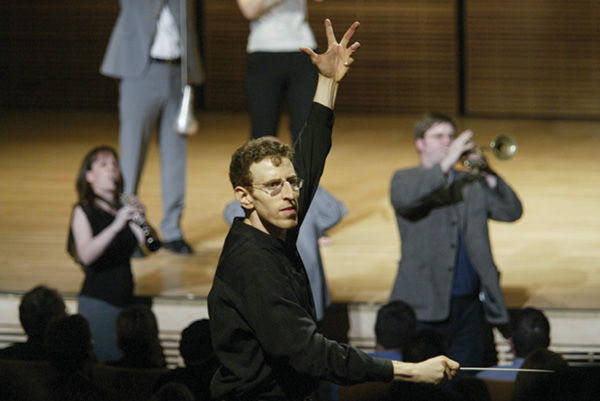‘Cave’ project brings together video, music and Abrahamic faiths
Published March 1, 2017
Caves are usually known for their darkness, but this month, one will come to town looking to spread a little light.
“We’re proud to be bringing it here, and we really want St. Louis to turn out because people will be missing something if they don’t get a chance to see it now,” Mont Levy said.
Levy is chairing the initiative to bring in “The Cave,” billed as a multimedia opera that derives its name from the Cave of the Patriarchs, the burial site of Abraham and Sarah in Hebron.
It combines recorded interview footage of Israelis, Palestinians and Americans with holy texts and live musical pieces composed for the presentation. The video, collected during the late 1980s and early 1990s, asks participants about spiritual figures such as Abraham, Isaac, Sarah, Hagar and Ishmael to explore individuals common to the history of all three of the major monotheistic religions – Judaism, Christianity and Islam.
The production, a product of the husband-and-wife team of Beryl Korot and Steve Reich, is sponsored by Arts & Faith St. Louis in collaboration with John Burroughs School. The three-act presentation will be spread across five video screens with music from the group Alarm Will Sound.
Levy said he first saw a video exhibition of “The Cave” about two decades ago in New York and hoped to someday showcase it here.
“I came upon this by accident, was absolutely mesmerized by the piece and left thinking this was an amazing vehicle for interfaith dialogue because it teaches lessons of connection to common ancestral roots of the Abrahamic faiths,” he said.
Levy believes that the performance will appeal to a broad audience and should raise vital questions for many viewers. He also feels that its appearance, in the wake of recent vandalism at Chesed Shel Emeth Cemetery in University City, makes such queries especially urgent.
“It took 24 years to get it here, and it is coming at a time where it couldn’t be more important,” he said.
Gavin Chuck, managing director of Alarm Will Sound, agrees.
“Over the course of time, the subject matter has only become more and more relevant to what is happening in the world,” he said.
Chuck said the music in the piece reflects how the interviewees speak.
“With a conventional composer, the music shapes the words,” he said. “In this case, the opposite has happened. The shapes and rhythms of the melodies are determined by the way that people speak naturally.”
The technique is innovative, he said, part of a more objective approach Reich takes in composing rather than using the music to “editorialize” about the composer’s views.
“Having the speech and what people are saying to drive the music is, in a way, him sort of stepping back and saying, ‘I’m just going to present these people from very different perspectives who are coexisting and answer these questions in very different ways,’ ” Chuck said.
The performances themselves won’t be the only events associated with “The Cave.” In fact, an entire suite of educational opportunities has grown up around the piece.
In February, Salem United Methodist Church, Eden Theological Seminary and the Sheldon Concert Hall hosted discussions or panels related to the music and subject matter highlighted by the project.
Those events will continue with two panel presentations this week: a 7 p.m. event on Abraham at Fontbonne University on Thursday; and a presentation at the Islamic Foundation of Greater St. Louis at 3 p.m. Sunday on the music and text of “The Cave.”
On April 6, “The Cave: Common Ground” will be the topic of a gathering at St. Louis County Library Headquarters, and Ladue Chapel Presbyterian Church will examine “The Poet Rumi: Love is the Bridge” on May 16. A discussion at the St. Louis Islamic Center Nur is slated to look at the commonalities of the three faiths June 11.
The idea of connecting an artistic piece to various learning events to deepen understanding of it has been done here before. The same model was used during a 2011 staging of “The Death of Klinghoffer,” a controversial 1991 opera by John Adams that centered on the murder of a Jewish man aboard the hijacked Achille Lauro cruise ship.
“St. Louis was a model of how it didn’t have to be divisive,” Batya Abramson-Goldstein recalled. “Actually, it brought the community together in many ways.”
It also helped lead to the creation of Arts & Faith St. Louis. Abramson-Goldstein was head of the local Jewish Community Relations Council during the Klinghoffer production. Though she’s now retired from that position, she was asked to help with community engagement for “The Cave.”
“Truthfully, the last thing in my mind was to get involved in a big project, but it spoke to me so strongly,” she said.
Part of that project has been the beginning of a teenage interfaith group with a dozen young people, four from each faith.
“It is small deliberately because we want there to be the opportunity for really getting to know each other in an in-depth way and a comfort level that allows for the most honest dialogue,” Abramson-Goldstein said. “We believe it will be transformational for them and they will reach out to their peers and extend the impact.”
In addition to dialogue and a joint service project, the teenage participants will also visit one another’s houses of worship during various holidays. A film will be made of the group’s activities, thanks to a grant from the Rubin and Gloria Feldman Family Education Institute at the local Holocaust Museum and Learning Center.















